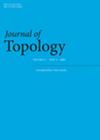k $k$ 正表面群表示的退化
IF 1.1
2区 数学
Q2 MATHEMATICS
引用次数: 0
摘要
我们引入了 k 个 $k$ 正表示,这是一大类 { 1 , ... , k }。 $\lbrace 1,\ldots ,k\rbrace$ -Anosov surface group representations into PGL ( E ) $\mathsf {PGL}(E)$,它们与希钦表示有许多共同特征,我们研究了它们的退化:除非它们是希钦表示,否则它们可以变形为非离散表示,但是任何极限至少是 ( k - 3 ) $(k-3)$ -正的,而不可还原极限是 ( k - 1 ) $(k-1)$ -正的。正比例表示的一般极限定理是一个重要的独立内容。本文章由计算机程序翻译,如有差异,请以英文原文为准。

Degenerations of
k
$k$
-positive surface group representations
We introduce -positive representations, a large class of -Anosov surface group representations into that share many features with Hitchin representations, and we study their degenerations: unless they are Hitchin, they can be deformed to non-discrete representations, but any limit is at least -positive and irreducible limits are -positive. A major ingredient, of independent interest, is a general limit theorem for positively ratioed representations.
求助全文
通过发布文献求助,成功后即可免费获取论文全文。
去求助
来源期刊

Journal of Topology
数学-数学
CiteScore
2.00
自引率
9.10%
发文量
62
审稿时长
>12 weeks
期刊介绍:
The Journal of Topology publishes papers of high quality and significance in topology, geometry and adjacent areas of mathematics. Interesting, important and often unexpected links connect topology and geometry with many other parts of mathematics, and the editors welcome submissions on exciting new advances concerning such links, as well as those in the core subject areas of the journal.
The Journal of Topology was founded in 2008. It is published quarterly with articles published individually online prior to appearing in a printed issue.
 求助内容:
求助内容: 应助结果提醒方式:
应助结果提醒方式:


